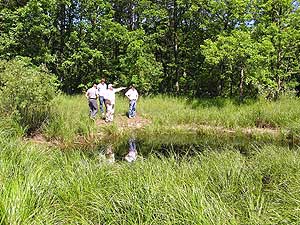|
Audio
Photos
Your Voice
|
Sinkholes sinking progress
July 5, 2004
 |
| Sinkholes are giving Askov residents a big headache. They're preventing the town from improving its sewage treatment system. (MPR Photo/Stephanie Hemphill) |
Askov, Minn. — Sinkholes are like icebergs - most of the action happens below the surface.
Calvin Alexander is a geologist and an expert on sinkholes. He's giving a guided tour of the sinkholes around Askov to the town's mayor. Sometimes they're hard to find.
Sinkholes start underground, but they might not be noticed for years because of the layers of soil that cover up what's happening down below.
Bedrock like limestone or sandstone is porous, so water flows through it. But in some places, cracks in the rock allow the water to flow faster. That pulls soil into the crack.
 | |||
"You get an actual hole in the soil at the top of the bedrock," explains Alexander. "That hole gets bigger and bigger, the ceiling starts falling, that dirt has to wash away, more ceiling falls, and it happens."
Suddenly the ground sinks, to fill the hole just above the bedrock.
In a hayfield, the farmer either fills in a sinkhole, or mows around it.
But a couple of sinkholes in Askov aren't in hayfields. They're right next to the town's sewage treatment ponds.
"They've been here probably 10,000 years," says Colin Voss, who manages Askov's sewage treatment system. He says these sinkholes could be making the ground water less pure.
 | |||
"They allow water to get into the aquifers a lot quicker than the normal percolation down through the soils," he says. "And then you don't have the filtration action of the soils. So you're getting dirtier water down into the aquifer itself."
The aquifer supplies water to wells for the homes around Askov. So the Minnesota Pollution Control Agency is concerned the wells could be polluted.
The agency noticed the sinkholes when they began the permitting process to upgrade Askov's 40-year-old treatment ponds.
Colin Voss says the ponds are starting to fill up with sludge, and they can't handle the rush of water that comes with spring snowmelt and summer storms.
"You get a big rain, we don't have enough capacity to hold the water to - at times - give it proper treatment," he says.
In fact, the MPCA has slapped a building moratorium on Askov. The town's mayor, Larry Seek, says he had to say "no" to a couple of families wanting to build homes in town.
"We've had a couple of businesses that have been interested in the area, and again, we have that moratorium, we cannot hook them to our current system," Seek says. "So the two things you're faced with in a small city, trying to obtain some type of business that's interested in your community, and then when you do and you have to turn them away, it really hurts."
The MPCA wants to learn how the ground water flows in the area, to find out whether wells are likely to be contaminated.
They put different colored dyes in the outflow from the treatment pond, and in the sinkhole nearby. The dyes quickly showed up in wells about a mile away. So far, tests have found no contamination.
One of the dyes turned up in Marlys Olesen's water. She says it's unsettling to know the water is traveling so directly from the sinkhole near the treatment pond to her well. And she can't picture how the town will solve the problem.
 | |||
"You know they can't build new sewer ponds out here because of the sinkhole problem," she says. "It's going to be interesting; it's a wait-and-see thing."
The MPCA plans to continue testing for the rest of the summer. Spokesman Steve Mikkelson says the town has a couple of options, all of them expensive.
"Move the ponds, build the new ones in different locations, or go to what's called a mechanical treatment plant which doesn't include these ponds," Mikkelson says. "Those would be a lot more expensive, but if there's a problem with discharges going into groundwater, then some things just probably can't be done."
Mikkelson says the solution is almost certainly going to be more than the tiny town of Askov can afford.
|
News Headlines
|
Related Subjects
|
